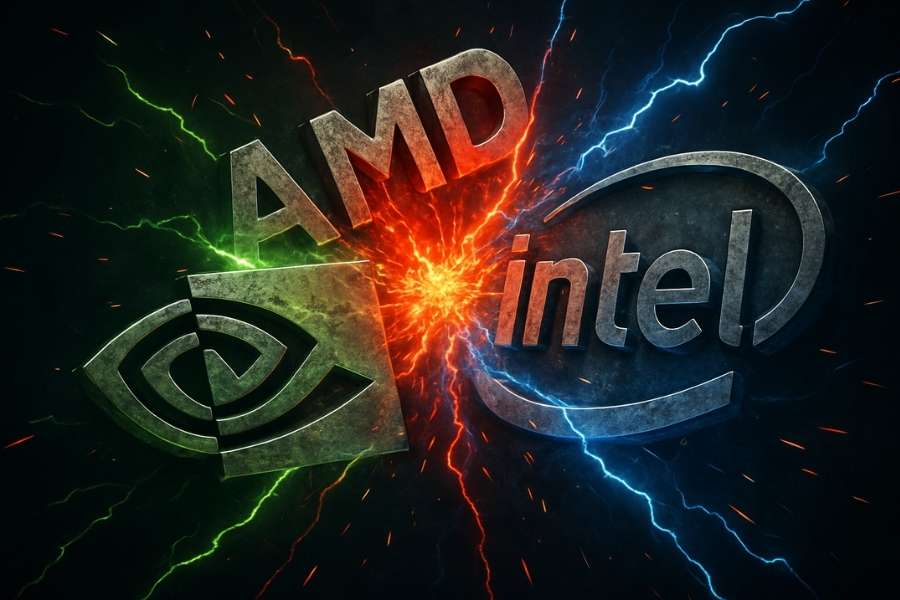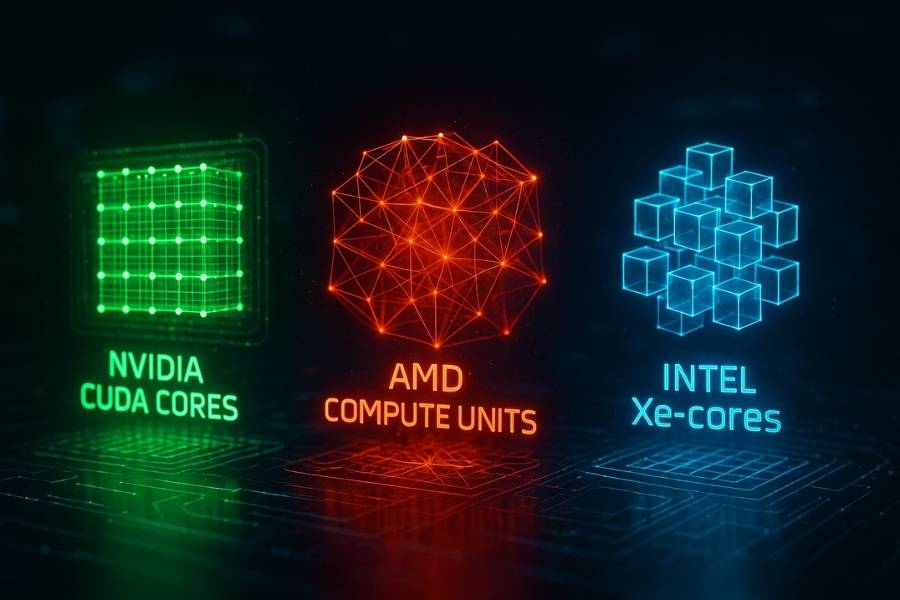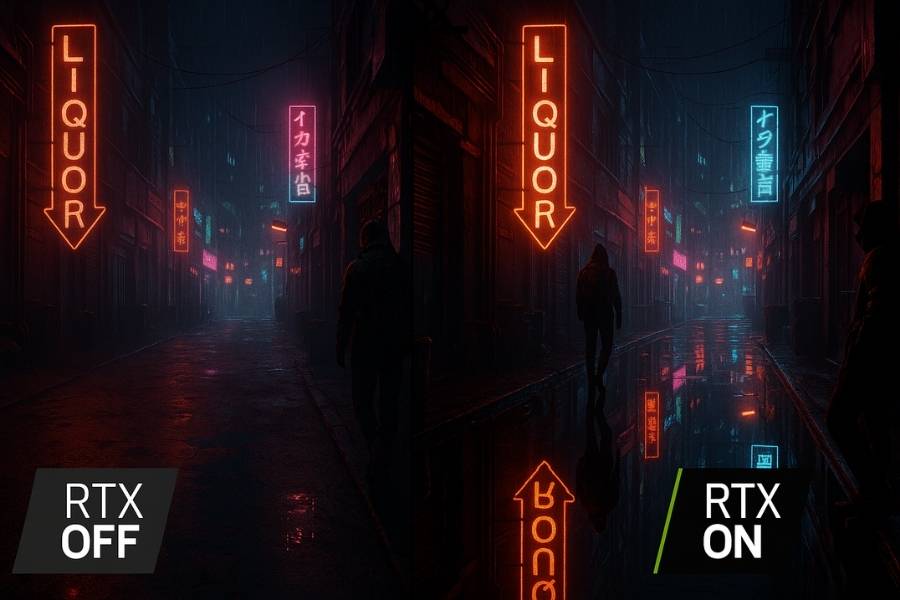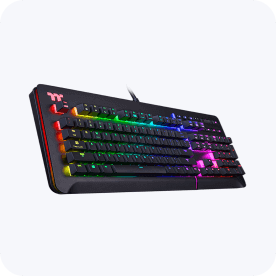

The Graphics Card Showdown: NVIDIA RTX vs. AMD Radeon for Indian Gamers & Creators (2025 Update)
Introduction: The GPU Scene in 2025
Thinking about building a new PC in 2025? You’re in for a treat! Right now, the race for the best graphics card is heating up, with NVIDIA, AMD, and Intel all bringing their best to the table. In today’s tech world, having a solid GPU isn’t just about playing the latest games smoothly; it’s also crucial for video editing, 3D rendering, and even running complex AI tasks.
This guide is your go-to resource for figuring out the "Intel vs NVIDIA vs AMD Graphics" showdown here in India. We’re going to look closely at what’s out there, comparing how they perform, their features, and importantly, how much bang you get for your buck. We want to help you find the best graphics card India in 2025 that fits your needs and budget. Choosing the right one means you’ll be set for the future while also unlocking some awesome performance!
Ready to explore the options? Let our experts at computerserversolutions.com help you craft your perfect custom PC build today!
The Evolution of GPUs: Should You Upgrade in 2025?
With all those shiny new graphics cards popping up, it can be tempting to jump on the newest models. But here’s the big question: do you really need the latest and greatest? The older models, like the NVIDIA 30 and 40 series, along with the AMD 6000 and 7000 series, still pack a serious punch. These cards are really solid, they've been tested a lot, and they offer great performance for their price-making them a smart choice for many people.
So, what’s the deal with the new NVIDIA 50-series and AMD 9000-series? Well, those cards come with some big improvements. Think better processors, AI features for things like DLSS and FSR, plus advanced ray tracing capabilities that make lighting and shadows look super realistic. It's not just about getting more frames; it’s about making everything work smarter and smoother, whether you’re gaming or creating content.
The decision to upgrade really depends on who you are and what you do:
-
For Gamers: If you want stunning 4K visuals or maxing out ray tracing settings in demanding games, the latest models offer a significant performance boost. Thanks to AI upscaling, you can enjoy higher frame rates without ruining the graphics.
-
For Creators: If you’re into 3D rendering, high-res video, or AI models, having a next-gen GPU can seriously cut down your project times. The investment really pays off here.
-
For Budget Builders: Older models are where you’ll find the best deals. Something like an RTX 30-series or RX 6000-series will give you amazing value for solid 1080p gaming, and we’ve got some great options in our Nehru Place store.
Don’t forget about Intel’s Arc graphics! With their new "Battlemage" line, they’re shaking things up and providing a budget-friendly alternative that really competes with NVIDIA and AMD.
NVIDIA vs. AMD: What’s the Difference in 2025?
When it comes down to NVIDIA vs AMD, there are some key differences in how they’ve designed their tech. Both want to give you the best experience, but they go about it differently. It’s crucial to know these differences to help you pick the right one. We’re also looking at Intel since their Arc series has become a true player in the game.
To simplify things, here’s a quick breakdown of what defines each brand in 2025:
|
Feature |
NVIDIA GeForce RTX |
AMD Radeon RX |
Intel Arc |
|
Core Tech |
CUDA Cores, Tensor Cores |
Compute Units, AI Accelerators |
Xe-cores, XMX Engines |
|
AI Upscaling |
DLSS (Deep Learning Super Sampling) |
FSR (FidelityFX Super Resolution) |
XeSS (Xe Super Sampling) |
|
Strengths |
Mature Ray Tracing, Pro App Support, AI Performance |
Strong Rasterization, Competitive Pricing |
Excellent AV1 Encoding, Great Value |
What does all this mean? NVIDIA's CUDA Cores are a big deal in professional fields, giving them an edge in video editing and 3D work. Their Tensor Cores are designed for AI, powering their top-notch DLSS tech.
Meanwhile, AMD has always been about "rasterization," which is all about how well games run without heavy ray tracing. They often give you more frames per dollar on games that don’t utilize ray tracing. Also, their FSR tech is open-source, meaning it works on most modern GPUs, which is super handy.
As for Intel, they’re all about value. Their XeSS upscaling goes head-to-head with NVIDIA and AMD, and they shine in media encoding—great for streamers and budget-conscious video editors. Choosing the right card depends on whether you want NVIDIA’s feature-rich options, AMD’s value, or Intel’s budget-friendly punch.
Raw Performance Benchmarks: Gaming in 1080p, 1440p, and 4K
Tech specs are super important, but for gamers, it really comes down to one big thing: frames per second (FPS). That’s where the real competition is. We’ve tried out some of the latest graphics cards across popular resolutions to give you a peek at the performance you can expect. Here’s how they stack up.
Budget Gaming: 1080p Benchmarks (High Settings)
This is the most popular resolution in India, and the competition is tough.
|
Graphics Card |
Cyberpunk 2077 (Avg. FPS) |
Valorant (Avg. FPS) |
|
NVIDIA RTX 4060 |
75 |
280 |
|
AMD RX 7600 |
82 |
310 |
|
Intel Arc A770 |
70 |
270 |

Analysis: When it comes to sheer performance, the AMD RX 7600 usually takes the lead, making it a solid choice for competitive gaming. The RTX 4060 is still a good option, especially if you're planning to use DLSS for a little boost.
The Sweet Spot: 1440p Benchmarks (High Settings)
This is the new standard for immersive, high-quality gaming.
|
Graphics Card |
Alan Wake 2 (Avg. FPS) |
Apex Legends (Avg. FPS) |
|
NVIDIA RTX 4070 Ti |
65 |
200 |
|
AMD RX 7800 XT |
60 |
225 |
Analysis: At this resolution, the cards are pretty evenly matched. The RTX 4070 Ti shines in graphically-intensive games like Alan Wake 2, especially with ray tracing (not shown). However, the RX 7800 XT’s raw power gives it an edge in fast-paced games like Apex Legends.
High-End Enthusiast: 4K Benchmarks (Ultra Settings)
For those who demand the absolute best visual experience.
|
Graphics Card |
Cyberpunk 2077 (RT: Overdrive) |
F1 24 (Avg. FPS) |
|
NVIDIA RTX 4090 |
80 |
150 |
|
AMD RX 7900 XTX |
62 |
165 |


Analysis: In the 4K game world, NVIDIA's RTX 4090 is still the top dog for demanding ray-tracing workloads. Meanwhile, the AMD RX 7900 XTX shows impressive strength in games that are well-optimized, often at a better price point.
Just a heads up, better performance usually means more power usage. So, thinking about power efficiency is key when planning your PSU and cooling for a well-balanced and reliable system.
Performance for Professionals: Which GPU Brand is Best for Video Editing, 3D Rendering, and AI?
For content creators, time is money. A solid GPU doesn’t just speed up games; it can also speed up your whole workflow, saving you hours on rendering and processing. Here, the hardware and software ecosystem really matters, often making the decision easier than in gaming.
-
Video Editing & Streaming: If you’re using apps like Adobe Premiere Pro, NVIDIA’s CUDA acceleration is still the best for smoother playback and faster exports. However, DaVinci Resolve works great on both platforms, making AMD a strong contender. For streamers and YouTubers, Intel’s Arc series shines with its top-notch AV1 encoding, giving you high-quality streams but smaller file sizes.
-
3D Rendering & Animation: This is where NVIDIA usually takes the lead. In programs like Blender and Maya, the combination of CUDA cores and dedicated Ray Tracing (RT) cores gives RTX cards a big edge. If you're serious about 3D work, the time you save while rendering can be huge, making an NVIDIA GPU a smart pick.
-
AI and Machine Learning: If you’re working with AI, like running large language models or creating art with Stable Diffusion, NVIDIA is the way to go. Their mature CUDA platform and dedicated Tensor Cores for AI tasks offer a performance that’s hard to beat.
A key factor for pros is VRAM. If you're editing 4K or 8K video or dealing with complex 3D scenes, you’ll need a decent amount of video memory. AMD often gives you more VRAM for your money at certain price points, which can make a difference for video editors looking at similarly priced cards.
Decoding the Cost: GPU Pricing and Availability in India (2025)
Performance benchmarks are cool, but at the end of the day, price matters most for most people. GPU prices in India can be tricky and often look different from prices in other countries. Knowing the costs is key to finding the best bang for your buck.
Here’s a general idea of what to expect for different tiers of graphics cards in the Indian market (prices in INR):
-
Budget Tier (e.g., RTX 4060, RX 7600): Usually falls in the 25,000 to 35,000 range. Great for entry-level 1080p gaming.
-
Mid-Range Tier (e.g., NVIDIA RTX 5070, RTX 4070/Ti; AMD RX 9700 XT, RX 7800 XT): This is a hot segment with a mix of new-gen and last-gen cards offering great value, typically ranging from ?45,000 to ?90,000.
-
High-End Tier (e.g., NVIDIA RTX 5090, AMD RX 9900 XTX): Expect to spend 1,80,000 or more for the latest 4K gaming power.
So, why do these prices tend to be higher in India? A few reasons come into play, like high import duties and GST, currency rates, and the extra costs from different manufacturers (like ASUS ROG cards costing more than basic models).
Also, prices in places like Nehru Place can change based on local stock and demand. That’s why it’s good to shop from reliable retailers. We can help you find the best deals any day of the week.
For the latest prices and to create an awesome custom PC that fits your budget, check out computerserversolutions.com or swing by our store in Nehru Place, Delhi.
Ecosystem and Features: DLSS, FSR, Ray Tracing, and More
When it comes to graphics cards, it's not just about the hardware; the software and cool features are what really make it shine. This is often where a lot of folks decide which card to buy because these technologies can really amp up your gaming and creative work.
One big area that's getting a lot of attention is AI-powered upscaling. This tech can boost your frames per second (FPS) by rendering the game at a lower resolution and then scaling it up smartly to match your screen.
-
NVIDIA's DLSS (Deep Learning Super Sampling): This is often seen as the best for image quality. DLSS uses special Tensor Core hardware in RTX cards and the latest version even includes Frame Generation, which makes new frames for smoother gameplay, but this is only available on the newest cards.
-
AMD's FSR (FidelityFX Super Resolution): What’s cool about FSR is that it’s open-source, so it works with almost any modern GPU, including those from NVIDIA and Intel. While it competes well image-wise, some die-hard fans still think DLSS has a tiny edge.
-
Intel's XeSS (Xe Super Sampling): Much like DLSS, XeSS uses AI to deliver solid performance boosts and is a strong competitor, making it another great choice for getting better FPS.
Ray Tracing is another big factor to think about. This feature gives you super realistic lighting, shadows, and reflections. Both AMD and NVIDIA support it, but NVIDIA usually performs a bit better thanks to its more advanced RT Core tech. AMD has made big strides with each new generation, but in the most demanding ray-traced games, NVIDIA often comes out on top.
And don’t forget about the extra software perks! NVIDIA has tools like NVIDIA Broadcast, which is awesome for streamers, as it uses AI to cut out background noise and create virtual green screens. On the other hand, AMD's Adrenalin software has features like HYPR-RX, making it super easy to boost performance with just one click. Both NVIDIA and AMD now provide reliable drivers so everything runs smoothly.

Conclusion: The Final Verdict - Which Card is Right for You?
Choosing the right graphics card in 2025 really boils down to this: the best GPU is the one that suits the games you play and the work you do. There's no point in getting a fancy top-tier card if you mostly work with Photoshop or enjoy older esports games. It's all about finding the best fit for your specific needs. Once you compare performance, features, and prices, making a clear choice is easier when you know what you’re primarily going to use it for.
Here is our final recommendation for every type of user:
-
The Budget Gamer (1080p): Check out the AMD RX 7600 for solid performance or consider a previous-gen NVIDIA RTX 3060/4060 for great features at a lower cost.
-
The eSports Competitor (High-Refresh Rate): If you want max FPS, go for the AMD Radeon RX 7800 XT or the new RX 9700 XT to get the power you need for a competitive edge.
-
The 1440p Sweet Spot Gamer: This one’s tougher. Pick the NVIDIA RTX 4070 Ti/5070 for stunning ray tracing visuals and DLSS, or go with the AMD RX 7800 XT/9700 XT for fantastic performance and value.
-
The 4K Enthusiast: If price isn’t an issue, the NVIDIA RTX 5090 is the top dog for an ultimate 4K ray-traced experience. The AMD RX 9900 XTX is a great contender, especially if you want pure gaming power.
-
The Video Editor/Streamer: For pro Adobe Suite users, an NVIDIA RTX card is what you want, thanks to CUDA. And for serious streamers, an Intel Arc GPU gives you awesome value with its top-notch AV1 encoding.
-
The 3D Artist/AI Developer: It’s a no-brainer. The powerful CUDA and Tensor cores in NVIDIA's RTX series are must-haves for professional 3D and AI work.
Remember, having the perfect PC is about more than just the graphics card; it’s about having a balanced system where every part works well together. That’s why chatting with an expert before buying is so important. Let Computer Server Solutions help you out in Delhi to tailor a machine that fits your needs and budget perfectly.
Frequently Asked Questions (FAQ)
Q1: Is 12GB of VRAM enough for gaming in 2025?
A: Generally, if you’re gaming at 1080p or 1440p, 12GB of VRAM should work just fine. However, if you’re going for 4K gaming with high-res textures and all settings maxed out, we suggest a card with 16GB or more for a smooth, stutter-free gaming experience.
Q2: Do I need a new motherboard to upgrade my graphics card?
A: Not usually. Most modern graphics cards fit into a PCIe x16 slot, which works with older motherboards. You just need to check that your Power Supply Unit (PSU) has enough wattage and the right connectors, plus make sure the new card fits in your case.
Q3: Are NVIDIA's drivers more stable than AMD's?
A: By 2025, driver problems are mostly a thing of the past. Both NVIDIA and AMD have really stepped up their software game, and both provide reliable driver packages. While some users have their favorites, either option should give you a great experience. We can help you figure out the best specifics for your build at computerserversolutions.com.
Q4: Can I use an Intel Arc GPU for serious gaming?
A: For sure! Intel's latest Arc graphics cards, especially the new "Battlemage" series, are a solid third choice in the market. They offer very competitive performance for their price, particularly in the budget to mid-range segments, and are a fantastic choice for a value-oriented gaming PC.













